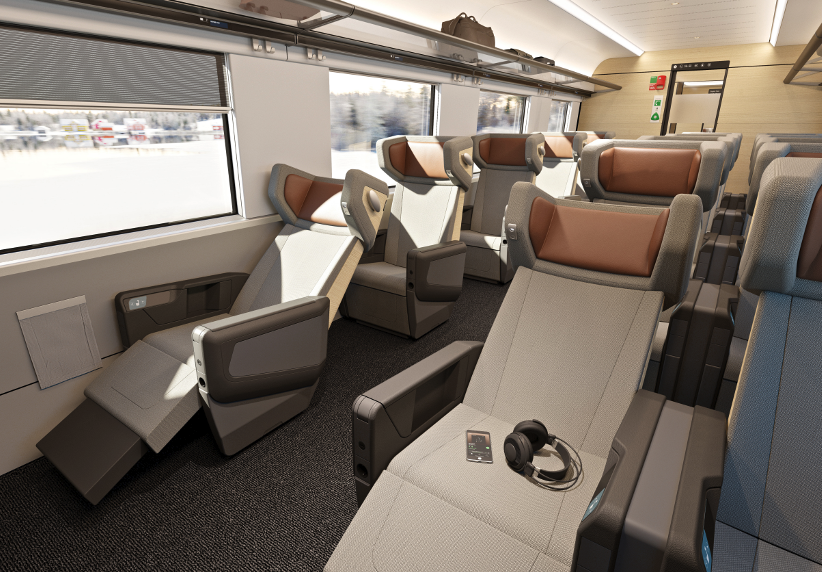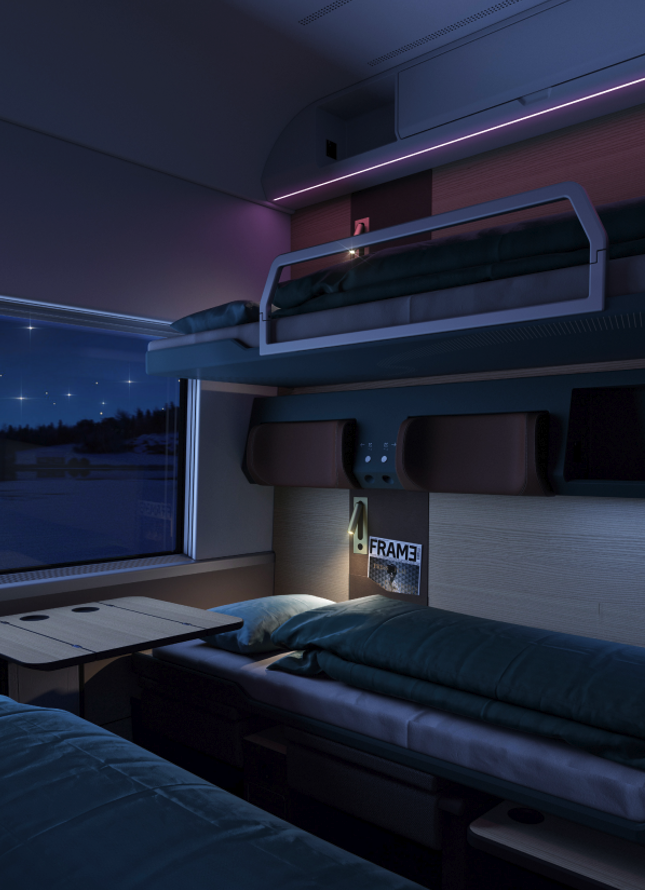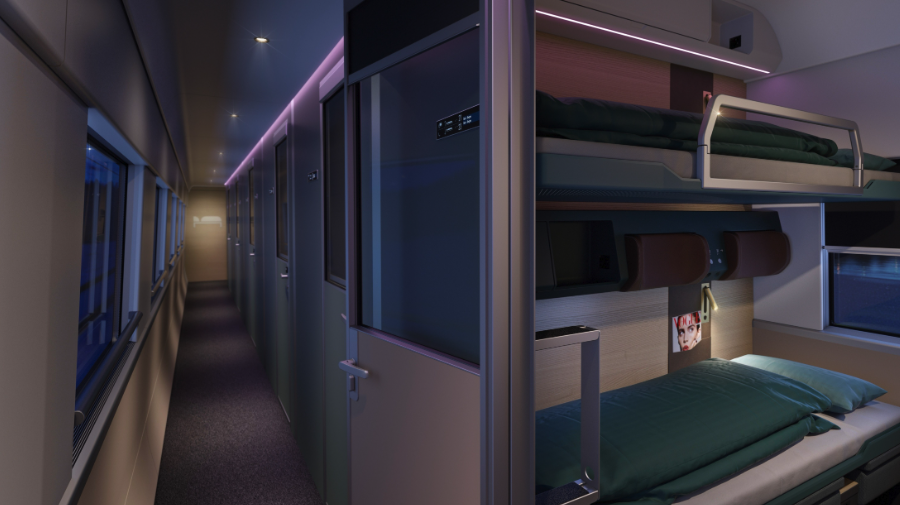A few days ago it was announced that Stadler has won the contract to supply new long distance trains to Norway. The official press release from Norske Tog in Norwegian is here, and there are articles from IRJ and Global Railway Review in English as well.
While this tender only concerns trains for use in Norway, there are a bunch of aspects of the tender and the winning bid that have relevance for the rest of Europe to justify a some detailed analysis.
First, the shipment times. A firm order for 17 8-carriage trains has been agreed now, and the framework contract covers delivery of up to 100 trains. The first trains are to be delivered to Norway in 2025 – so three years from now – and are to run in 2026 (Global Railway Review) or 2027 (Norske Tog) – I presume this means from the mid-December 2026 timetable change. That is three years and nine months from now. And that for a semi-bespoke design of train. Sure, Stadler has delivered trains to Norway before – but with a carriage and wheel layout very different to the one in the rendering shown to win this tender.
I repeatedly hear that were a night train operator to make an order for new trains, the earliest they could run – even simple carriages to be hauled by a locomotive! – would be five years from now. And here is Stadler promising a semi-bespoke EMU design to be ready in less than four years. That’s radical.
Second, the interior design.
These trains are to have a kind of convertible day-night design – although working out how this is going to work exactly needs a bit of educated guessing from the renderings provided by Stadler and included in Norske Tog’s press release.
There are to be reclining seats – in what looks like a 2+1 arrangement in open carriages:
And compartments, shown here in night time formation – but you can observe headrests too – so the beds will fold, and relatively traditional compartment accommodation will be provided – this would seem to show 4 beds per compartment, and either 4 or 6 seats per compartment in daytime formation:
The press release says “Det blir et bredere sovetilbud med både liggestoler, 2-sengskupeer og 4-sengskupeer. Sovekupeene vil på dagtid kunne gjøres om til lukkede sittegrupper for både familier og forretningsreisende, og liggestolene vil kunne benyttes hele døgnet” – “There will be a wider range of sleeping options, including reclining seats, 2-bed compartments and 4-bed compartments. The sleeping compartments will be converted into closed seating areas for families and business travellers during the day, and the reclining seats will be available 24 hours a day.”
So despite all the pastel tones and neat renderings, this leaves me rather underwhelmed as to how this is going to be in the nighttime. Open carriages – when passengers are moving around, and a train is passing through brightly lit stations – have never been a winner for me at night. And there is nothing like the innovation of ÖBB’s mini compartments from the new NightJet designs here.
That brings me to the third point – capacity.
These new trains each with 8 carriages are – according to Norske Tog – to have a capacity of “up to 542 seats per train”. That looks… optimistic. Other 8 carriage, distributed traction designs have much lower capacity – a DB ICE 3 (class 403) has 441 seats, and a Trenitalia Frecciarossa 1000 has 457. All of these designs – including the new Stadler trains for Norway – have a dining car in the composition.
So how, I wonder, is Stadler going to cram in a hundred more seats than a ICE3 and eighty more than a Frecciarossa? OK, these trains have fewer doors, but is that enough? And yes, the loading gauge in Norway is wider than in Germany or Italy, so a 3+2 seating arrangement in at least some of the train might be possible (but that’s absent from both the renderings and the press release), but compartments generally have a lower capacity than open carriages. It strikes me that something is not altogether right with the numbers here.
Related is the fourth point – flexibility.
These trains will have fixed 8 carriage formations. Theoretically a double set could be run – so 16 carriages – but I am pretty sure no stations in Norway other than Oslo S have 400 metre platforms. Perhaps simply running a more dense timetable in the busier winter and summer months, and a thinner timetable off season in spring and autumn, is the solution here. But these trains are less flexible to operate than the locomotive hauled trains on the Bergen line they will replace.
The fifth point is the enigma about traction.
“Det kjøpes tog for både elektrifiserte og ikke-elektrifiserte strekninger” – “Trains are purchased for both electrified and non-electrified lines“. So not only is this a new design of train, but it is to be some kind of a hybrid as well? I presume this means that some of the later orders will have a battery-electric option (Stadler is known for its battery-electric EMUs) but it would be a fair assumption that the first 17 trains – intended for the fully electrified Bergen line – will be electric only. [UPDATE 20.2.2023, 19:15: Bjørn Bäuchle has pointed me towards the initial tender information that stipulates that 10 of the trains will be electric, 4 will be hybrid, and for 3 more it is to be determined – but that leaves me even more confused. Why were these numbers not re-stated in the press release announcing the award of the tender?]
In the end all of this leaves me wondering: if Stadler and Norske Tog can manage to do all of this, why is no-one else attempting something like this? Although the questions about capacity and traction mean perhaps the end product might not end up being quite as good as this press fanfare makes us think.
Photo credits: renderings from Stadler, provided to Norske Tog and various other outlets.





” So not only is this a new design of train, but it is to be some kind of a hybrid as well? I presume this means that some of the later orders will have a battery-electric option ” My guess would be that some of the trains are to be initially equipped with the same type of diesel generator that is presently used in the type-76, https://www.norsketog.no/tog/type-76. As far as I have understood, the hope is that the diesel generators some time in the future may be replaced with batteries or hydrogen based generators or other types of fuel.
Hmmm, but if this is so, why so scant detail of this when the announcement was made?
The split for the 17 long distance trains are (all replacing night trains and can run one distance in daytime in addition (not on the 729km long Nordlandsbanen)):
Bergensbanen – 7 trains (Oslo-Bergen) (replacing all night trains and day trains)
Sørlandsbanen – 3 trains (Oslo-Stavanger)
Dovrebanen – 3 trains (Oslo-Trondheim)
Nordlandsbanen – 4 trains (Bimodal due to lack of electrification)
No trains will be longer than 200-220meter and no 400m trains will be run.
Most of the possible future 100 trains will be 4 cars (100meter day trains) replacing type 73 and probably increasing numbers and service.
It’s possible that the 4-car day car variant may be extended to a 5-car variant (in some cases) or even a 6-car variant.
No long distance train in Norway (2 hours +) use 3+2 seating, but 2+2 will be the most common.
Thanks for the clarifications, but how with 2+2 are you going to get 542 seats in a 8 carriage version?
I cannot understand this skepticism. The new trains mean innovation and the experience with Stadler has been very good. Let’s let the people do their work.
Stadler is excellent. But this looks like a Eierlegende Wollmilchsau of a definition of what a long distance train should be!
Oh and these trains cost MORE per carriage than a 300km/h ICE3. Nice if you’re Stadler, less nice if you are Norske tog.
Norske tog wants to get away from having like 15, 20 and 22 each of 3-4 different types of long distance trains.
There are at the moment 3 different companies running the 4 long distance lines and the biggest problems are that all have very few of each type of the current available types of trains. And one big problem is that each company must keep their own pool of spare parts for 2-3 different train types/models, Norske tog doesn’t keep spare parts for the companies.
There are many more costs to running trains than just the purchase cost so the main plan in Norway is to go from 7-10 different train models to only 3-4 trains models, but subtypes are allowed (example Stadler Flirt type 74, 75 and 76).
It’s actually worse, currently only 4 types/models of long distance trains with only 4, 7, 7 and 14 of each . To keep spare parts for only 3-4 trains of one type for each company is a pain.
Sure, that makes sense. But there are different ways to do that. You could – for example – have gone for an adapted Siemens Vectron + Railjet/Nightjet type of model. Then the traction and the accommodation parts are separate, and adapting the trains for the different lines would then be a lot easier.
Don’t forget that standardisation isn’t only about Norway. If a model of train is universal throughout Europe that helps with the spare part supply.
Sure, these Stadler trains ordered will have *some* parts in common with earlier Stadler models in Norway, but not all.
As for the costs… well this solution costs upwards of €5m per carriage for Norske tog. You can purchase ICE3 carriages (300km/h!) for less. So I am not sure this is necessarily a cost effective decision.
Of the possible 100 trains about 70-75% will be 4-car trains and it’s not a good idea to use one Vectron locomotive with only 3 carriages.
So why is all the communication – publicly – about 8 carriage trains then?